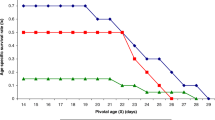Abstract
A strong relationship exists between body size and fitness in parasitoids. However, it is unclear whether the relationship is symmetric or asymmetric in males and females. The present study investigated the body size and fitness relationship in Diaeretiella rapae emerged from small and large nymphs of cabbage aphid Brevicoryne brassicae. A positive relationship existed between the size of the aphid host and growth of parasitoid larva developing in it. The fitness gain in males and females was not proportionate to their body size gain. Females mated with larger males produced 10 % more female offspring than females mated with smaller males. However, females that developed in large hosts produced 62 % more offspring (total male and female) than the females emerged from smaller hosts. The findings suggest that the number of offspring and the progeny sex ratio were affected by the body size of both male and female D. rapae.




Similar content being viewed by others
References
Abe J, Kamimura Y, Shimada M (2005) Individual sex ratios and offspring emergence patterns in a parasitoid wasp, Melittobia australica (Eulophidae), with superparasitism and lethal combat among sons. Behav Ecol Sociobiol 57:366–373
Bernal J, González D (1997) Reproduction of Diaeretiella rapae on Russian wheat aphid hosts at different temperatures. Entomol Exp App 82:159–166
Charnov EL (1982) The theory of sex allocation. Princeton University Press, New Jersey, USA
Charnov EL, Los-den Hartogh RL, Jones WT, van den Assem J (1981) Sex ratio evolution in a variable environment. Nature 289:27–33
Chown SL, Gaston KJ (2010) Body size variation in insects: a macroecological perspective. Biol Rev 85:139–169
Couchman JR, King PE (1979) Effect of the parasitoid Diaeretiella rapae on the feeding rate of its host Brevicoryne brassicae. Entomol Exp App 25:9–15
Godfray HCJ (1994) Parasitoids: behavioral and evolutionary ecology. Princeton University Press, Princeton, USA
Hammerstein P, Selten R (1994) Game theory and evolutionary biology. In: Aumann R, Hart S (eds) Handbook of game theory with economic applications, vol 2. Elsevier, Amsterdam, The Netherlands, pp 929–993
Harvey JA, Strand MR (2002) The developmental strategies of endoparasitoid wasps vary with host feeding ecology. Ecology 83:2439–2451
Henry LM, Ma BO, Roitberg BD (2009) Size-mediated adaptive foraging: a host-selection strategy for insect parasitoids. Oecologia 161:433–445
Jervis MA, Kidd NAC (1986) Host-feeding strategies in hymenopteran parasitoids. Biol Rev 61:395–434
Joyce AL, Bernal JS, Vinson SB, Lomeli-Flores R (2009) Influence of adult size on mate choice in the solitary and gregarious parasitoids, Cotesia marginiventris and Cotesia flavipes. J Insect Behav 22:12–28
Kant R, Sandanayaka WRM, He XZ, Wang Q (2008) Effect of host age on searching and oviposition behaviour of Diaeretiella rapae (M’Intosh) (Hymenoptera: Aphidiidae). N Z Plant Protect 61:355–361
Kant R, Minor MA, Trewick SA, Sandanayaka WRM (2011) Host selection for self-superparasitism by Diaeretiella rapae (M’Intosh) (Hymenoptera: Aphidiidae). N Z Plant Protect 64:37–43
Kant R, Minor MA, Trewick SA (2012a) Fitness gain in a koinobiont parasitoid Diaeretiella rapae (Hymenoptera: Braconidae) by parasitising hosts of different ages. J Asia Pac Entomol 15:83–87
Kant R, Minor MA, Trewick SA (2012b) Reproductive strategies of Diaeretiella rapae (Hymenoptera: Aphidiinae) during fluctuating temperatures of spring season in New Zealand. Biocontrol Sci Techn 22:1–9
Kant R, Minor MA, Trewick SA (2012c) Mating or oviposition? A crucial decision in the life history of cabbage aphid parasitoid Diaeretiella rapae (M’Intosh) (Hymenoptera: Aphidiidae). Ecol Entomol (in press)
Lacoume S, Bressac C, Chevrier C (2006) Effect of host size on male fitness in the parasitoid wasp Dinarmus basalis. J Insect Physiol 52:249–254
Mackauer M (1986) Growth and developmental interactions in some aphids and their hymenopterous parasites. J Insect Physiol 32:275–280
Mackauer M, Sequeira R (1993) Patterns of development in insect parasites. In: Beckage NE, Thompson SN, Federici BA (eds) Parasites and pathogens of insects. Academic Press, New York, USA, pp 1–23
Morris R, Fellowes M (2002) Learning and natal host influence host preference, handling time and sex allocation behaviour in a pupal parasitoid. Behav Ecol Sociobiol 51:386–393
Perry G, Pianka ER (1997) Animal foraging: past, present and future. Trends Ecol Evol 12:360–364
Pike KS, Stary P, Miller T, Allison D, Graf G, Boydston L, Miller R, Gillespie R (1999) Host range and habitats of the aphid parasitoid Diaeretiella rapae (Hymenoptera: Aphidiidae) in Washington state. Environ Entomol 28:61–71
Sagarra LA, Vincent C, Stewart RK (2001) Body size as an indicator of parasitoid quality in male and female Anagyrus kamali (Hymenoptera: Encyrtidae). Bull Entomol Res 91:363–368
Sequeira R, Mackauer M (1992) Nutritional ecology of an insect host-parasitoid association: the pea aphid Aphidius ervi system. Ecology 73:183–189
Stearns SC (1992) The evolution of life histories. Oxford University Press, UK
Stephens DW, Krebs JR (1986) Foraging theory. Princeton University Press, New Jersey, USA
van Alphen JJM, Visser ME (1990) Superparasitism as an adaptive strategy for insect parasitoids. Annu Rev Entomol 35:59–79
Visser ME (1994) The importance of being large—the relationship between size and fitness in females of the parasitoid Aphaereta minuta (Hymenoptera: braconidae). J Anim Ecol 63:963–978
Wyckhuys KAG, Stone L, Desneux N, Hoelmer KA, Hopper KR, Heimpel GE (2008) Parasitism of the soybean aphid, Aphis glycines by Binodoxys communis: the role of aphid defensive behaviour and parasitoid reproductive performance. Bull Entomol Res 98:361–370
Zhang WQ, Hassan SA (2003) Use of the parasitoid Diaeretiella rapae (McIntosh) to control the cabbage aphid Brevicoryne brassicae (L.). J Appl Entomol 127:522–526
Acknowledgments
The research project was supported by a Massey University Doctoral Research Scholarship and Helen E. Akers PhD Scholarship to Rashmi Kant. We thank Dr. Mariana Bulgarella, Massey University and two anonymous referees for their suggestions on improving this manuscript.
Author information
Authors and Affiliations
Corresponding author
Additional information
Handling Editor: Torsten Meiners
Rights and permissions
About this article
Cite this article
Kant, R., Minor, M.A., Trewick, S.A. et al. Body size and fitness relation in male and female Diaeretiella rapae . BioControl 57, 759–766 (2012). https://doi.org/10.1007/s10526-012-9452-4
Received:
Accepted:
Published:
Issue Date:
DOI: https://doi.org/10.1007/s10526-012-9452-4




